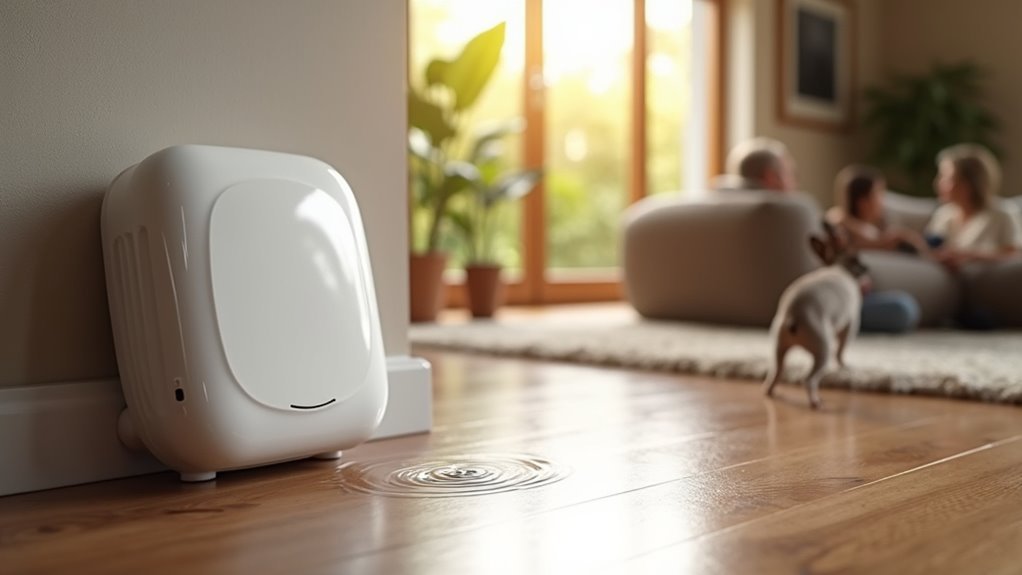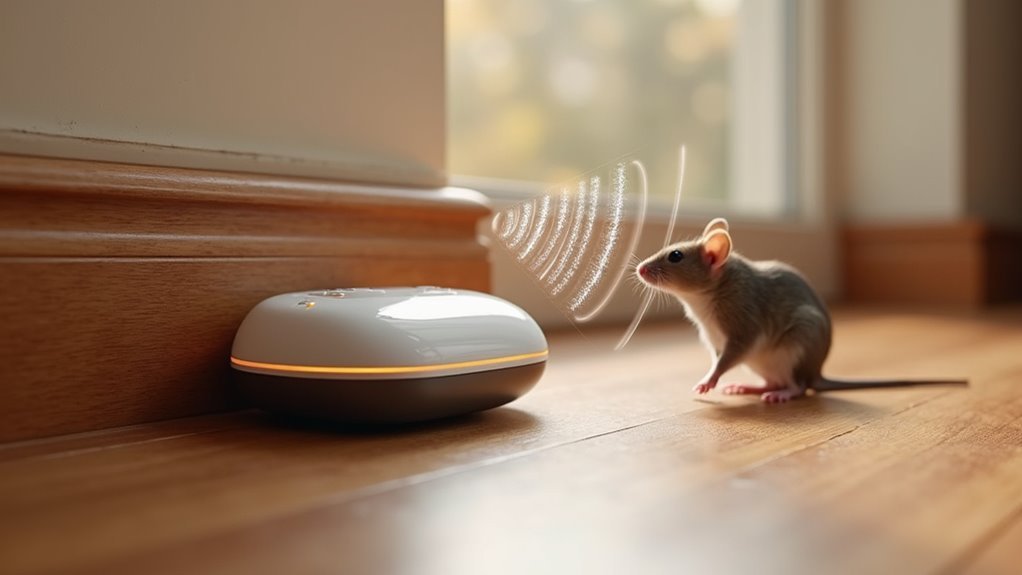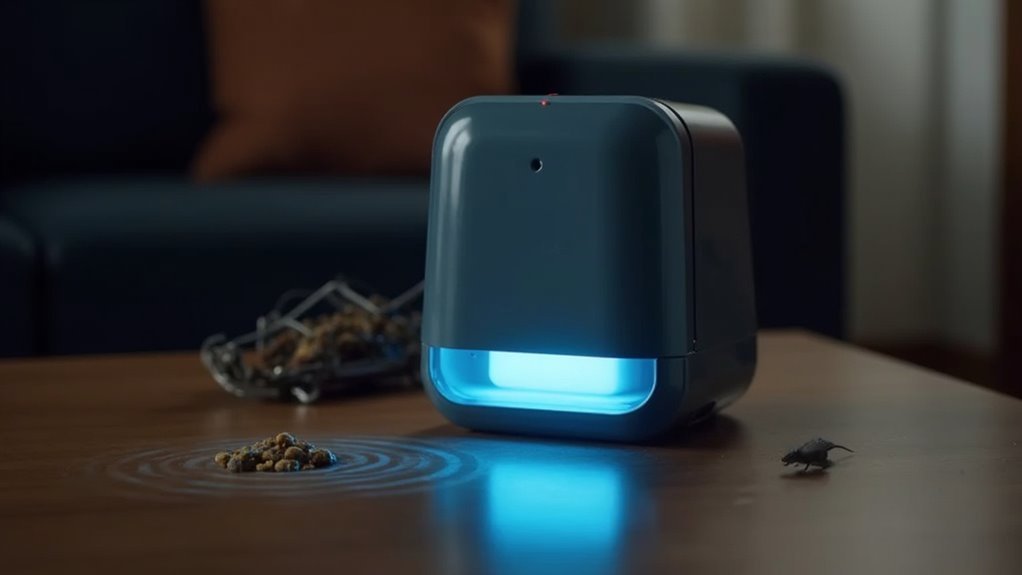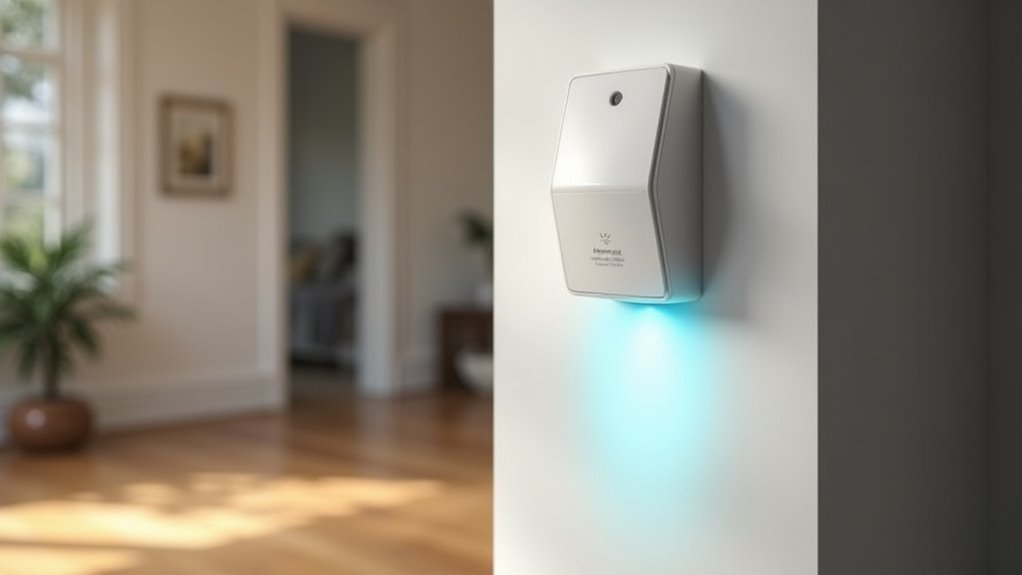Ultrasonic monitors revolutionize your home rodent control by emitting high-frequency sound waves above 20 kHz that create uncomfortable environments for pests without using toxic chemicals or lethal traps. You’ll benefit from a humane deterrent system that’s inaudible to humans but effectively disorients rodents through targeted frequency ranges. These DIY systems include microcontrollers, PIR sensors, and LCD displays for user-friendly operation, offering a modern alternative to traditional pest control methods. Understanding proper placement and maintenance strategies will maximize your system’s long-term effectiveness.
Understanding How Ultrasonic Technology Works Against Rodents

While traditional rodent control methods rely on traps and poison, ultrasonic technology takes a different approach by emitting high-frequency sound waves above 20 kHz that you can’t hear but rodents can detect.
These sound waves create an uncomfortable environment that disorients the pests and drives them away from treated areas. Unlike traditional methods that kill or capture rodents, ultrasonic devices work as a deterrent system.
Ultrasonic pest control creates an uncomfortable sonic environment that deters rodents rather than eliminating them through lethal means.
However, you’ll find their effectiveness varies depending on the rodent type and environmental conditions. The sound waves can’t penetrate walls or solid objects, limiting coverage areas.
That’s why effective pest management requires combining ultrasonic devices with other pest control measures for thorough rodent protection throughout your home.
Key Components of DIY Ultrasonic Monitoring Systems
The heart of any DIY ultrasonic monitoring system lies in its microcontroller, which serves as the brain that regulates high-frequency sound wave emissions typically ranging from 20 kHz to 125 kHz. You’ll find these devices incorporate passive infrared sensors that detect movement and automatically trigger ultrasonic waves when pests approach.
| Component | Function | Benefit |
|---|---|---|
| Microcontroller | Regulates frequency/amplitude | Creates disorienting environment |
| PIR Sensor | Detects movement | Guarantees timely response |
| LCD Display | Shows settings/status | User-friendly monitoring |
Your ultrasonic control system requires strategic placement of multiple units since these waves can’t penetrate solid objects. The varying frequencies effectively target rodents while remaining inaudible to humans and pets, maximizing your coverage area throughout different rooms.
Scientific Evidence Behind Ultrasonic Pest Deterrence

You’ll find that scientific research on ultrasonic pest deterrence presents mixed and often disappointing results.
Studies from Cornell University and the University of Arizona reveal limited effectiveness, with devices providing only temporary relief before rodents adapt to the high-frequency sounds.
The frequency range above 20 kHz that these devices operate on doesn’t consistently create the uncomfortable environment manufacturers claim it will.
Research Studies Results
Although manufacturers tout impressive success rates, scientific research tells a starkly different story about ultrasonic pest deterrents.
Cornell University’s 2016 study found no substantial evidence supporting these ultrasonic pest control devices’ effectiveness against rodent problems. The University of Arizona’s 2020 research confirmed limited results in controlled environments, highlighting inconsistency in real-world applications.
You’ll discover that scientific studies reveal mixed responses from rodents, who often adapt to ultrasonic frequencies over time.
While cockroaches show temporary susceptibility, rodents remain largely unaffected. The FTC’s 2001 warning about exaggerated manufacturer claims emphasizes this disconnect between marketing promises and actual performance.
When choosing your pest control strategy, you’re better off relying on traditional pest control methods backed by solid scientific evidence rather than ultrasonic devices.
Frequency Effectiveness Analysis
Beyond these disappointing research findings lies a deeper technical issue: the specific frequencies these devices emit don’t deliver the promised results. You’ll find that ultrasonic devices operating between 20-125 kHz face significant limitations that professional exterminators have long recognized.
| Frequency Range | Initial Effect | Long-term Result |
|---|---|---|
| 20-40 kHz | Moderate response | Habituation occurs |
| 41-80 kHz | Variable reaction | Reduced effectiveness |
| 81-125 kHz | Minimal impact | No sustained control |
| Combined ranges | Temporary displacement | Pests return |
The habituation problem means pests quickly adapt to these sounds. You can’t achieve thorough pest control when rodents simply ignore the frequencies after initial exposure. While these devices might temporarily reduce pests in small areas, they won’t provide the reliable, long-term protection you need for effective home rodent management.
Setting Up Your Home Ultrasonic Rodent Defense Network
You’ll need to place multiple ultrasonic devices throughout your home since these waves can’t penetrate walls or solid barriers.
Focus on positioning units in high-activity areas like kitchens, basements, and main entry points where rodents typically travel.
Strategic placement guarantees you’re maximizing coverage and creating an effective barrier that forces pests to encounter the deterrent frequencies wherever they attempt to establish territory.
Strategic Device Placement
A chess master carefully positions each piece for maximum strategic advantage, and your ultrasonic rodent defense network requires the same thoughtful approach.
Strategic device placement determines whether your ultrasonic pest repellers succeed or fail in protecting your home. Position devices near entry points, kitchens, and storage areas where you’ve observed rodent activity.
Since sound waves can’t penetrate walls, you’ll need multiple units to cover different rooms effectively. Each device typically covers 1,200 square feet, so calculate your coverage accordingly.
Mount units at least 12 inches off the ground for ideal sound transmission. Don’t place them behind furniture or in enclosed spaces, as obstructions block sound waves.
Coverage Area Optimization
While ultrasonic devices offer promising rodent control potential, their effectiveness hinges entirely on creating overlapping coverage zones that eliminate sonic shadows throughout your property.
Since these devices typically cover 20-30 feet and can’t penetrate walls, you’ll need strategic placement in every room where rodents might travel. Focus your coverage area optimization efforts on high-risk zones like kitchens, basements, and attics where infestations commonly begin.
You’ll achieve better results by using multiple ultrasonic devices with varying frequencies to repel pests without allowing habituation.
Sound waves don’t bend around furniture or obstacles, so position units with clear sight lines. Regularly monitor rodent activity and adjust device locations accordingly.
This systematic approach guarantees thorough protection against pests without gaps in your defensive network.
Comparing Ultrasonic Methods to Traditional Pest Control

When choosing between ultrasonic and traditional pest control methods, you’re comparing two fundamentally different approaches to rodent management. Ultrasonic pest devices emit high-frequency sound waves to create an uncomfortable environment for various pests, while traditional methods rely on chemical treatments and physical traps for direct elimination.
| Aspect | Ultrasonic Methods | Traditional Methods |
|---|---|---|
| Effectiveness | Inconsistent, unproven results | Proven, immediate elimination |
| Duration | Temporary relief, pests adapt | Long-lasting control |
| Safety Testing | Largely unregulated market | Rigorous safety standards |
| Coverage | Limited range, multiple units needed | Extensive approach possible |
| Results | Variable quality, inconsistent | Standardized, measurable outcomes |
You’ll find traditional approaches offer more reliable, scientifically-backed solutions compared to ultrasonic alternatives.
Maximizing Effectiveness Through Strategic Device Placement
Three critical factors determine whether your ultrasonic monitors will effectively deter rodents: proper positioning, adequate coverage, and strategic frequency variation.
You’ll need strategic placement of multiple ultrasonic devices throughout your home since high-frequency sound waves can’t penetrate walls or furniture. Position each device within its 20-30 foot effective range, focusing on areas with visible rodent activity and near entry points.
Strategic placement of multiple ultrasonic devices is essential since high-frequency sound waves cannot penetrate walls or furniture effectively.
You’ll maximize effectiveness by using devices with different frequencies, as various pests respond better to specific sound ranges.
Place your monitors in unobstructed locations away from solid barriers to guarantee ideal sound wave projection.
Don’t forget to regularly reposition your devices—rodents can become habituated to singular frequencies over time, making rotation essential for maintaining long-term deterrent success.
Maintenance and Optimization of Your Ultrasonic System
Since ultrasonic devices require consistent upkeep to maintain their deterrent power, you’ll need to establish a regular maintenance routine that keeps your system operating at peak performance.
Clean your devices regularly to remove dust and debris that can obstruct sound wave emission. Monitor rodent activity changes to determine if your system’s working effectively or if you need additional pest control measures.
Optimize device placement by ensuring minimal interference from furniture and walls, as sound waves can’t penetrate these obstacles.
Consider upgrading to newer models with variable frequencies that adapt to pest behavior. Pest control professionals recommend strategic placement of multiple units for thorough coverage.
Track your system’s effective range and adjust positioning accordingly to maximize the uncomfortable environment these devices create for rodents.
Frequently Asked Questions
Do Ultrasonic Devices Really Repel Rodents?
You’ll find ultrasonic devices provide limited rodent control effectiveness. While they may cause temporary discomfort, rodents often adapt to the sounds. You shouldn’t rely on them alone but incorporate them into extensive pest management strategies.
What Is the New Technology for Rodent Control?
You’ll find smart ultrasonic monitors with PIR sensors automatically detect rodent presence and activate variable frequencies to prevent habituation. These devices integrate with smartphone apps for real-time alerts and sustainable pest management.
What Are the Disadvantages of Ultrasonic Pest Repellers?
You’ll find ultrasonic pest repellers lose effectiveness as rodents adapt to the sounds. They can’t penetrate walls, requiring multiple units. Studies show limited long-term success, and product quality varies considerably.
What Are the Benefits of Ultrasonic Pest Repellers?
You’ll enjoy chemical-free pest control that’s safe around children and pets. These devices operate silently to humans while continuously deterring rodents without requiring baits, traps, or toxic substances in your home.
In Summary
You’ve discovered how ultrasonic monitors can transform your rodent control strategy. By understanding the technology, setting up strategic networks, and maintaining your system properly, you’re equipped to create an effective defense against unwanted pests. Unlike traditional methods, ultrasonic solutions offer a humane, chemical-free approach that won’t disrupt your daily life. Start implementing these techniques today, and you’ll enjoy a rodent-free home without the hassle of conventional pest control methods.





Leave a Reply